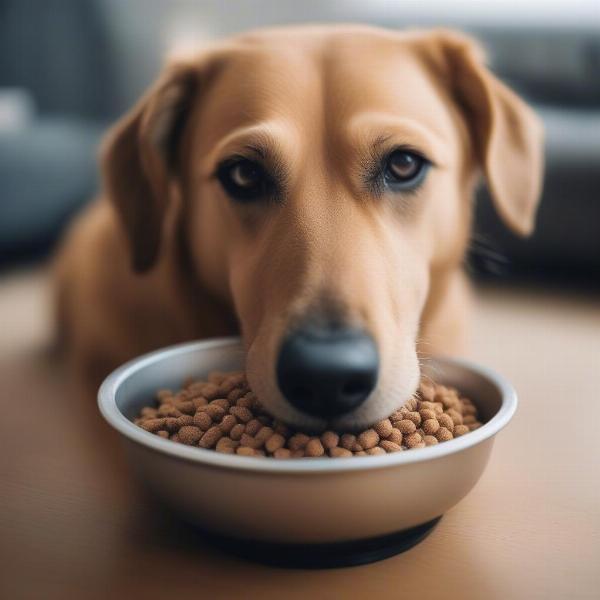High fibre dog food plays a vital role in maintaining a dog’s digestive health. From promoting regular bowel movements to managing weight and even preventing certain health conditions, understanding the benefits of fibre and how to choose the right high fibre food for your canine companion is essential for responsible pet ownership. This guide will provide you with a comprehensive understanding of high fibre dog food, its benefits, and how it can contribute to a healthier, happier life for your furry friend.
Understanding the Importance of Fibre in a Dog’s Diet
Just like humans, dogs require a balanced diet that includes fibre for optimal digestive health. Fibre is a type of carbohydrate that isn’t digestible by the dog’s body. It acts as a bulking agent in the digestive tract, promoting healthy bowel movements and preventing constipation and diarrhoea. Fibre also helps regulate blood sugar levels, can aid in weight management, and can even play a role in preventing certain health conditions like diabetes and colon cancer.
Different Types of Fibre
There are two main types of fibre: soluble and insoluble. Soluble fibre dissolves in water, forming a gel-like substance in the digestive tract. This type of fibre helps regulate blood sugar levels and can lower cholesterol. Insoluble fibre doesn’t dissolve in water and adds bulk to the stool, promoting regularity. Both types of fibre are important for a dog’s health and are found in various ingredients commonly used in high fibre dog food.
Choosing the Right High Fibre Dog Food
Selecting the right high fibre dog food can feel overwhelming with so many options available. Here are some key factors to consider:
- Your dog’s age and breed: Puppies and senior dogs may have different fibre requirements compared to adult dogs. Certain breeds are also more prone to digestive issues and may benefit from a specific type of high fibre diet.
- Underlying health conditions: If your dog has any existing health problems, such as diabetes or inflammatory bowel disease, consult your veterinarian before making any dietary changes. They can recommend the best high in fibre dog food for your dog’s specific needs.
- Ingredients: Look for high-quality ingredients such as whole grains, fruits, vegetables, and beet pulp. Avoid foods with fillers, artificial colours, and flavours.
- Fibre content: Check the guaranteed analysis on the dog food label to determine the fibre content. A higher percentage doesn’t always mean better, so consult your vet for guidance on the appropriate fibre intake for your dog.
Transitioning to High Fibre Dog Food
Introducing a new food should always be done gradually to avoid upsetting your dog’s stomach. Start by mixing a small amount of the new high fibre food with your dog’s current food. Slowly increase the proportion of the new food over several days until the transition is complete.
Benefits of High Fibre Dog Food
What are the benefits of feeding a high-fibre diet? High fibre diets can offer various benefits, including:
- Improved digestion and regular bowel movements
- Weight management by promoting satiety
- Blood sugar regulation
- Management of anal gland problems
- Prevention of certain health conditions
 Dog Eating High Fibre Food
Dog Eating High Fibre Food
“A balanced diet with adequate fibre is crucial for a dog’s overall well-being,” says Dr. Emily Carter, DVM. “It supports healthy digestion, helps maintain a healthy weight, and can even prevent certain medical conditions.”
Conclusion
Choosing a senior dog food uk with the right amount of fibre is essential for your dog’s health. Understanding the different types of fibre and the factors to consider when selecting high fibre dog food can help you make informed decisions that contribute to your dog’s overall health and well-being. Remember to consult with your veterinarian before making any significant dietary changes, especially if your dog has any pre-existing health conditions. By providing your dog with a balanced diet that includes adequate fibre, you are taking a proactive step towards ensuring a long, healthy, and happy life for your furry companion.
FAQ
- How much fibre does my dog need? The ideal fibre intake varies depending on factors such as age, breed, and health status. Consult your veterinarian for personalized recommendations.
- Can too much fibre be harmful? While fibre is beneficial, excessive amounts can lead to digestive upset. Follow the feeding guidelines on your chosen dog food.
- What are some signs of fibre deficiency in dogs? Signs may include constipation, diarrhoea, and weight gain.
- Are all high fibre dog foods the same? No, they differ in fibre type, source, and overall nutritional profile. Choose a food that suits your dog’s individual needs.
- What are some good sources of fibre for dogs? Good sources include beet pulp, pumpkin, sweet potatoes, and brown rice.
- Can I add fibre supplements to my dog’s food? Consult your veterinarian before adding any supplements to your dog’s diet.
- How can I transition my dog to a high-fibre diet safely? Gradually introduce the new food over several days, mixing it with their current food to avoid digestive upset.
Related Articles
About ILM Dog
ILM Dog is your trusted international resource for expert dog care and breed information. We cover a wide range of topics, from dog breed selection and health to training, nutrition, grooming, and product recommendations. Whether you’re a first-time owner or a seasoned dog lover, ILM Dog provides practical advice and reliable information to help you give your canine companion the best possible care. Contact us at [email protected] or +44 20-3965-8624. For more expert advice and resources, visit us at ILM Dog.